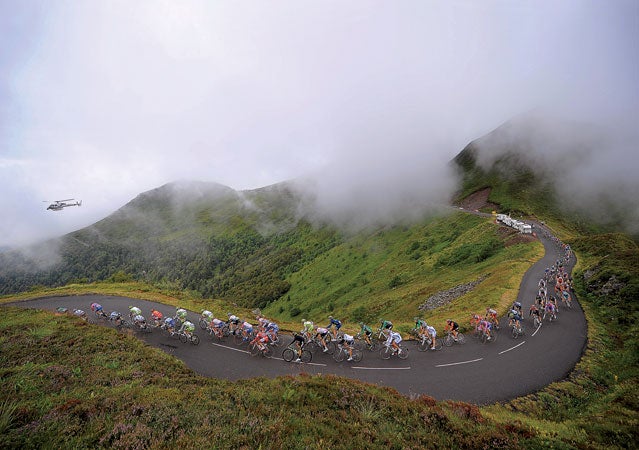There’s no clear favorite. Remember the days when Lance would win the prologue, his team would steamroller everyone during the first mountain stage, and there was zero suspense about what the outcome would be? This year will be the opposite. With three-time winner Alberto Contador banned after testing positive for steroids at the 2010 race, the peloton will be lacking an obvious patron, or boss, when it departs from Parc d’Avroy, in Liége, on June 30. Cadel Evans, the 2011 champion, is just one of a half-dozen potential favorites. Which means there will be all kinds of unpredictable drama: lots of attacks, numerous lead changes, and, very likely, a first-time champion. Perhaps someone like Juan Jose Cobo, the surprise winner of the 2011 Vuelta a España. Juan who? Exactly.
Johnny Hoogerland injury
 Johnny Hoogerland after tangling with a barbed-wire fence last year. Expect more spills at the 2012 Tour.
Johnny Hoogerland after tangling with a barbed-wire fence last year. Expect more spills at the 2012 Tour.
Extreme carnage. Not to say that we root for disasters, but the occasional crash does liven things up. Consider what happened in 2011: Team Sky captain Bradley Wiggins broke his collarbone during one 25-rider pileup. A high-speed skid on a slick descent knocked out Omega Pharma-Lotto captain Jurgen Van Den Broeck with a collapsed lung and Astana captain Alexandre Vinokourov with a fractured femur. A France TV car rammed Team Sky’s Juan Antonio Flecha and Vacansoleil-DCM’s Johnny Hoogerland into a barbed-wire fence. Pundits blamed the havoc on abundant wind and rain, but Contador, whose shot at another maillot jaune was felled by three tumbles, pointed to the leaderless peloton: “Many riders thought they could win, so everyone wanted to be at the front,” he said. “With the small roads it’s not possible, so you end up with many crashes.” With the race even more wide-open this year, expect chaos.
Fastest. Bike. Ever. Road-bike designs have gotten so good that teams are forced to add weight to frames so bikes meet minimum standards (14.99 pounds). That leaves aerodynamics as the way to gain an advantage, and engineers are utilizing wind tunnels to perfect sleek foil-shaped tubes with minimal drag. This year’s standout is Cervélo’s blade-thin S5. It’s the first aero bike to push the UCI’s weight minimum and the first to employ hydraulic brakes—a combo that will help riders save energy in the early stages. “It’ll keep guys fresh for the mountains,” says former Armstrong teammate Jonathan Vaughters, director of Cervélo-sponsored Garmin-Barracuda. Aero bikes like the S5 could also offer a distinct advantage on a day like Stage 4, when cyclists ride the coast along the English Channel and strong winds could create decisive time gaps.
It’s a “race of truth.” That’s the insider terminology for the time trial, because with each racer riding alone against the clock, there are no team tactics to hide behind. The fastest cyclist wins. Period. This year’s course has three individual time trials for a total distance of about 63 miles, the most since 2007. That will suit specialists like time-trial world champions Tony Martin and Fabian Cancellara, and should tip the race in favor of defending champion Evans and Bradley Wiggins, who are among the best time-trialists in the world. And for climbers like 2011 overall runner-up Andy Schleck and his brother Fränk? The truth will probably hurt.
USA! USA! While it’s unlikely that an American will win this year’s Tour, Omega Pharma–Quick-Step’s Levi Leipheimer and Garmin-Barracuda’s Christian Vande Velde and Tom Danielson all have outside chances at podium spots. Meanwhile, we can cheer on the upcoming generation of Yankee stars—kids like Andrew Talansky, 23, who took second at this year’s Tour de Romandie and has a shot at winning the white jersey for best young rider. And though 21-year-old Taylor Phinney isn’t guaranteed to make Cadel Evans’s BMC Tour squad, if he does he could very well win the 4.5-mile prologue, given his recent success in the opener of the Giro d’Italia. Then there’s 23-year-old Tejay Van Garderen, a proven stage racer (third at the 2010 Critérium du Dauphiné and the 2011 USA Pro Cycling Challenge), who will be doing domestique duty for Evans, especially on big mountain stages. If he happens to sneak into a breakaway and gain enough time, he could become the dark horse for the overall. “BMC is not putting big expectations on either Tejay or Taylor,” says team manager Jim Ochowicz. “But we’re very fortunate to have two of the future talents of the sport on our team.”


